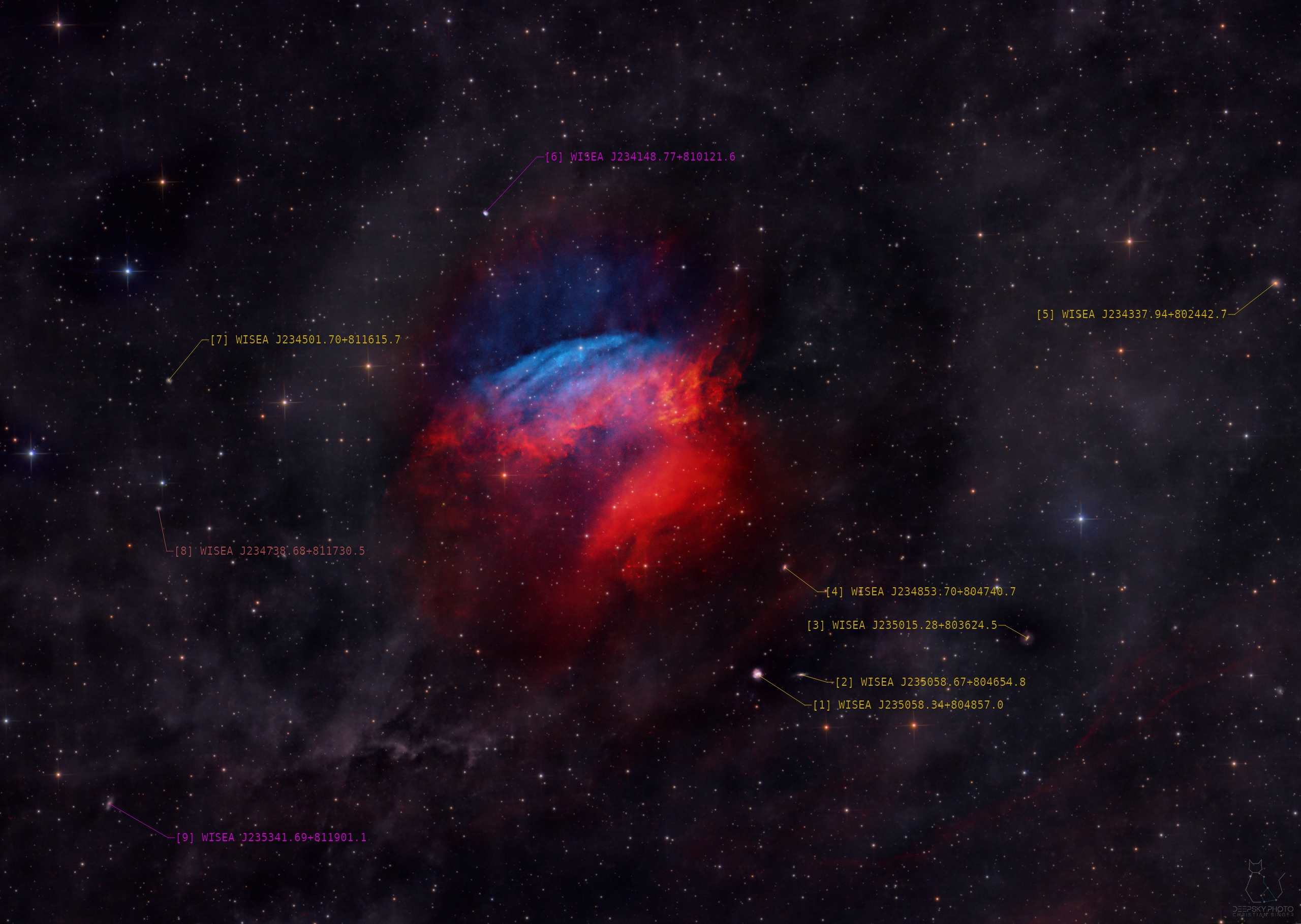Planetary nebula in constellation “Cepheus”
Project #14
Sh2-174 is a planetary nebula in the constellation Cepheus.
It is one of the most northerly planetary nebulae in the nightsky. This makes it almost exclusively observable for the Northern Hemisphere.
This distance between Earth and this deepsky object is estimated to be around 980 light years.
What could be better to drop SH2-174 (the “Valentine Rose”) as your 14th project on Valentine’s Day, the 14th of February.
Dedicated to my beloved wife :)!
Hope you like it, wishing you and your loved ones a happy Valentine’s Day!

SH2-174 – Project Publications
Bild-Veröffentlichungen
Nachfolgend sind alle projektbezogenen Details zu dieser Revision zu finden.
Having a closer look on the starless image, I took the time to identify some interesting objects:

| Number | Object Name / Type | Distance [mly] | Size [kly] |
| 1 | WISEA J235058.34+804857.0 / Galaxy | 384,28 | 93,74 |
| 2 | WISEA J235058.67+804654.8 / Galaxy | 609,49 | 89,40 |
| 3 | WISEA J235015.28+803624.5 / Galaxy | 488,78 | 106,16 |
| 4 | WISEA J234853.70+804740.7 / Ultraviolet Source | NA | NA |
| 5 | WISEA J234337.94+802442.7 / Galaxy | 422,73 | 82,42 |
| 6 | WISEA J234148.77+810121.6 / Ultraviolet Source | NA | NA |
| 7 | WISEA J234501.70+811615.7 / Galaxy | 1361,47 | 225,83 |
| 8 | WISEA J234738.68+811730.5 / Infrared Source | NA | NA |
| 9 | WISEA J235341.69+811901.1 / Ultraviolet Source | NA | NA |
The identification of those objects was done with Aladin and NED.
What’s really interesting is the fact that I also captured UV and IR sources. While the wavelength of UV is between 10 and ~400nm (the lower bound is UV-A), IR starts at ~700nm.
The graph below shows the visible light range between ~400nm and ~700nm.

So taking into account, that my light frames also included signal from both UV and IR, I had a closer look into the specification of my Antlia filters.
- SII, CWL=671.6nm (+/- 4,5nm)
- Halpha, CWL=656.3nm (+/- 4,5nm)
- OIII, CWL=500.7nm (+/- 4,5nm)
.. and as for L-RGB;

So that led me to the assumption, that those “sources” should be visible in the LUM-, BLUE- and RED-stacks, but also partly in OIII- and SII-stacks.
WR134 – Projektdetails
Nachfolgend sind alle projektbezogenen Details zu dieser Revision zu finden.
| Astrobin Link | SH2-174 / The “Valentine Rose”, a rare gem – first light in LRGBSHO |
| Weitere Veröffentlichungen | spektrum.de – SH2-174 / »Valentinsrose« – ein seltenes Juwel am Nachthimmel |
| Astronomisches Objekt | SH2-174 |
| Coordinates | RA center: 23h 46m 49s. 14 DEC center: +80° 53′ 54″.1 |
| Distanz zur Erde | 980ly |
| Grösse / Durchmesser | roughly 20arcsecs |
| Aufnahmedatum | January & February 2024 |
| Aufnahmedetails | Antlia V-Pro Luminance 36 mm: 45×120″(1h 30′) Antlia V-Pro Red 36 mm: 45×120″(1h 30′) Antlia V-Pro Green 36 mm: 27×120″(54′) Antlia V-Pro Blue 36 mm: 22×120″(44′) Antlia EDGE SII 4.5 nm 36 mm: 30×600″(5h) Antlia EDGE Halpha 4.5nm 36 mm: 50×600″(8h 20′) Antlia EDGE OIII 4.5 nm 36 mm: 18×600″(3h) Integration: 20h 58′ |
| Kalibrierung | BIAS / DarksA "dark frame" is shot in the dark (so e.g. covering your camera) with the same exposure as your light frames (e.g. 180sec, 300sec, 600sec) and contains the dark signal (and the so called "thermal noise", if not -properly- cooled). Those frames allow you to remove the sensor noise from your light frames, but also to tackle pixel errors (hot and cold pixels). The combination/stack of multiple dark frames is called a "Master Dark". More / FlatsA "flat frame" is shot against a bright surface and contains vignetting and all the "bad" things (e.g. dust particles) that block/disturb your light train. The combination/stack of multiple flat frames is called a "Master Flat". More / DarkFlatsA "darkflat frame" is basically the same as a flat frame with the same exposure and camera settings, but shot in the dark. They are used to calibrate the flat frames. The combination/stack of multiple darkflat frames is called a "Master DarkFlat". More |
| Equipment | Mount: Skywatcher NEQ6-R PRO (the old w/o USB-interface) Telescope: Lacerta Carbon Photonewton (250mm/1000mm, f/4) Camera: DeepSkyPro2600 mono Corrector: Pál Gyulai GPU Komakorrektor Guiding: ZWO ASI120MM + 50mm Helica |
| Software | Sternwarten-Steuerung: Sequence Generator Pro Guiding: PHD Nachbearbeitung: Astro Pixel Processor + GraxPert + PixInsight + Photoshop |
